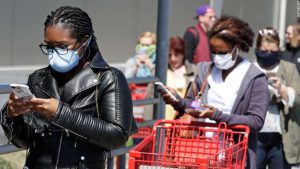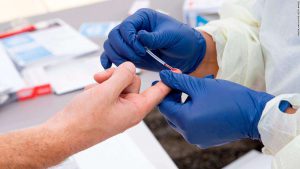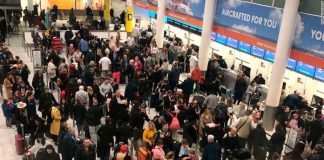MAY 27, 2020

Taylor Williams, left, and other shoppers what in line to enter a Traders Joes store, Monday, April 6, 2020, in Woodmere Village, Ohio. Only 25 customers are allowed in the store at one time. – Tony Dejak/AP
With the number of people in the United States who have died from the novel coronavirus on the verge of passing 100,000, Americans are at odds over whether it’s necessary to keep taking protective measures, including wearing a face covering.
A leading researcher says the data is clear: The path ahead in the Covid-19 pandemic is being shaped by masks.
“We now have really clear evidence that wearing masks works — it’s probably a 50% protection against transmission,” Dr. Chris Murray, director of the Institute for Health Metrics and Evaluation, or IHME, at the University of Washington, told CNN late Tuesday.
“And so, what happens in the next month or two is very much in the hands of how people respond.”
But as health experts stress the importance of wearing masks, the matter has gotten political. President Donald Trump has foregone face coverings in public while his presumptive rival Joe Biden has worn one, staking their ground in the partisan debate over whether masks are a paranoid restriction or a necessary precaution.
At least 1,694,599 people in the US have been infected with the virus by Wednesday and 99,983 people have died, according to Johns Hopkins University.
The number of US deaths forecast by August has shifted to 132,000 — 11,000 fewer than projected a week ago — according to the IHME’s model, one of more than a dozen highlighted by the US Centers for Disease Control and Prevention.
Behavioral changes like wearing masks could be responsible for the reduction, Murray said.
Dr. Anthony Fauci told CNN on Wednesday morning that “simple” things like wearing masks and washing hands are crucial.
“Those are the things that everybody should seriously consider doing,” said Fauci, the nation’s top infectious disease expert.
Many officials have urged their residents to wear masks. Former acting CDC director Dr. Richard Besser called it “an American thing to do,” and Ohio Gov. Mike DeWine said wearing a mask isn’t political, it’s “about loving your fellow human being.”
Still, warmer weather and a holiday weekend drew large crowds from their homes and into public spaces recently, with many faces uncovered.

People hang out on a sandbar on Lake Tillery Monday in Mount Gilead, North Carolina. – Al Drago/Getty Images
Fauci said such close gatherings of people without masks were “very troubling. … That’s really tempting fate and asking for trouble.”
A “second wave” of coronavirus infections is not inevitable, Fauci said, with proper identification, isolation and contract tracing.
Tests could be wrong and danger could be higher

A health worker takes a drop of blood for an antibody test at the Diagnostic and Wellness Center in Torrance, California. – Valerie Macon/AFP/Getty Images
Many reopenings also are contingent on testing and data showing that the transmission of the virus is low. But the accuracy of some tests has been called into question.
Antibody tests used to determine whether people have been infected in the past with Covid-19 might be wrong up to half the time, the CDC said in new guidance posted on its website.
Health care providers might need to test people twice, the CDC said. The tests that look for evidence of an immune response to infection are not accurate enough to make policy decisions.
There are also implications for individual decision making. Although there is little evidence yet to show that having recovered from the virus provides immunity from contracting Covid-19 again, health experts worry that a test that falsely shows the presence of antibodies would influence people to behave as if they had the infection and are now protected.
And the numbers may even be confounded by tests for current illness.
Doctors are increasingly reporting that they cannot find evidence of the virus until they perform tests deep in the respiratory system. Many children have come into hospitals severely ill but do not test positive until after repeated tests.
It is not only a problem for treating patients — it calls into question whether low reports in cases really means it is time to reopen workplaces and public spaces.
How the infection numbers are trending
Infection rates vary from state to state.
Illinois appears to be entering a “downward trend,” with the week ending May 16 being the first with a lower number of coronavirus deaths than the week before, Illinois Public Health Director Dr. Ngozi Ezike said at a news conference.
But the possible trend is still at its early stages, Ezike said, and the public has a responsibility to continue to decrease transmission.
New York, the hardest-hit state for the virus, reported Monday that 73 residents died in a single day, the lowest daily death toll since the start of the pandemic in the US, Gov. Andrew Cuomo said.
But other regions do not have the same good news. There were 14 states as of Wednesday in which the number of cases was still trending upward.
Mississippi Gov. Tate Reeves warned residents to stay vigilant because the state is still seeing a steady number of cases.
Meanwhile, Michigan Gov. Gretchen Whitmer said, despite pressure from the public and a decline in cases, the state is also not letting its guard down.
“Now, I’m not going to be bullied into ignoring the science and making political calculations,” Whitmer said. “Let’s not, us here in Michigan, have made this sacrifice in vain, and see our numbers start to rise again. … That means masks and distancing, and hand washing.”
Washington, DC will move Friday into Phase 1 of reopening, Mayor Muriel Bowser announced at a news conference.
The district has had a 14-day decline in cases of community spread of coronavirus as reported by the DC Department of Health’s calculations, one of the district’s key metrics for reopening.
“I want to clarify this: Covid-19 is still in our community, in our region, in our nation,” Bowser said. She warned that moving into Phase 1 means more people can get exposed as more people are out in the community.
There have been 8,406 cases of the coronavirus in the district, with 445 deaths.
Bowser said the July 4 parade Trump wanted was canceled “several weeks ago.” She said that “our big concern would be around how to manage fireworks and we will continue to work with (the Department of the) Interior on that.”
Steady numbers spark reopenings
Every state has begun to reopen, lifting restrictions on businesses and public spaces often in phases specific to the needs of the area.
Large gatherings could resume soon in Florida.
Walt Disney World on Wednesday proposed reopening Magic Kingdom and Animal Kingdom on July 11, and EPCOT and Hollywood Studios on July 15, in a presentation by Jim McPhee, senior vice president of operations at Walt Disney World.
Employees and guests would be required to wear face coverings and go through temperature screenings before entering the parks. Guests would have to reserve attendance in advance.
There would be soft openings before July 11 for employees and others, McPhee said. Orange County’s mayor and Florida’s governor still must sign off.
Also in Florida, Miami-Dade County Mayor Carlos Gimenez announced that beaches and hotels may reopen on Monday.
Gimenez said lounging on the sand, walking, swimming and jogging will be allowed with restrictions, including social distancing of at least 6 feet and wearing masks when that is not possible.
Hotels will be allowed to reopen at 100% capacity, with common areas held to 50% capacity.
In California, Gov. Gavin Newsom said, “We are walking into the unknown.”
The state was one of the first to impose restrictions and has been on the back end of lifting them.
More than 80% of counties in the state are allowed to begin the third of a four-phase reopening plan. This stage includes allowing hair salons and barbershops to reopen along with retail shops.
The state has reported 99,810 cases and 3,826 deaths, but hospitalizations have been declining slightly over the past two weeks, and the number of those in ICU beds remains stable, the governor said.
The state’s final phase of reopening includes resumption of concerts and spectator events, but Newsom says, “we are not there yet.”

A waiter serves patrons at L’escale restaurant in Greenwich, Connecticut. John Moore/Getty Images
Courtesy/Source: CNN









































































































